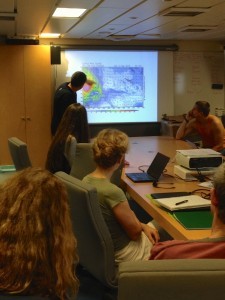I’ve never been good at navigating. When I come out of the subway I invariably turn the wrong direction, even though I already have my nose buried in Google Maps, and then walk around the block to save face.
The navigation strategy for this cruise, however, is one that is particularly tailored to my strengths: we’re using DNA to guide our trek through the South Pacific.
Each day, water is sampled from the surface ocean down to around 40 meters, and a team of graduate students from Stockholm University extracts the DNA from the microbes within these samples. Then they use a technique called quantitative polymerase chain reaction, or qPCR, which enables them quantify the number of copies of particular genes within a sample. This technique requires pipetting miniscule volumes of liquid into microscopic tubes with razor sharp precision—a challenging feat on land, and one that makes me seasick just thinking about on a moving ship. This qPCR technique is being used to look for hotspots of a particular, newly discovered group of unicellular nitrogen-fixing bacteria called UCYN.
Unlike Trichodesmium, which I can identify in a water sample just by looking, the UCYN group is mysterious and elusive. First off, they’re tiny and unicellular, so even under the microscope they can’t be distinguished from other bacteria. To make matters more complicated, many are thought to live in symbiotic association with larger eurkaryotic microbes. The physiology of these organisms is interesting as well: they’re cyanobacteria, but some are thought to be missing half of the photosynthetic machinery. In short: these critters are weird, but they have a potentially overlooked but critically important role in the marine nitrogen cycle.

